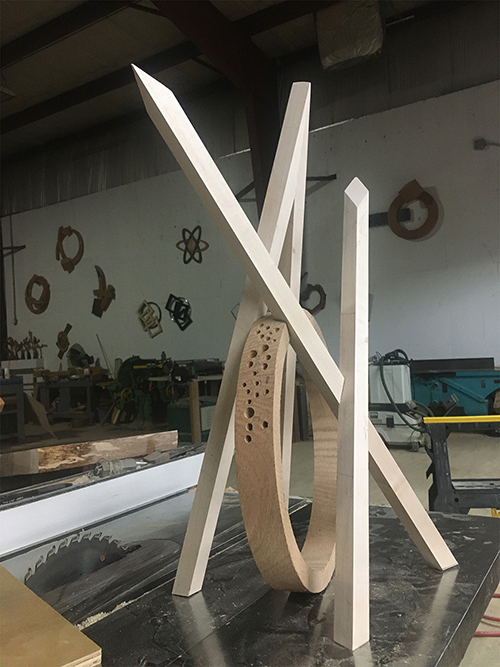
“Stargazing With Contrails.” Terrence Karpowicz (MAQUETTE IMAGE SUPPLIED BY ARTIST)

PAUL KRAINAK
Karpowicz received a Fullbright Award in the late ’70s to study industrial architecture in England. He worked with a millwright whose meticulous craft continues to influenced his thinking and practice. His intent was to find the best way to handle massive forms with a confidence that a tradition like windmill design could afford.
Consequently, his feel for sculpture is partially attributable to 700 years of engineering.
When I think of Karpowicz’s sculpture I recall the stockpile of railroad timber that nourished his initial development. His work often had deliberate rotating movement subtly underlining the form, skill and labor demanded to display it. It featured the artist’s aptitude for his objects in a scale nearly comparable to domestic architecture. His austere structures’ bare wood was a factor in insinuating overlooked details of structures like airplane hangars, agricultural sheds and assembly plants. Pivoting volumes and profiles were replete with gracefully fluctuating interior and exterior spaces. He endorsed a perspectival rewrite of the modern public monolith, peripherally linking fragments of the region’s agronomic narrative and an expanded industrial dimension of Chicago’s architectural legacy.
After moving primarily to outdoor sculpture, Karpowicz adapted materials like granite, stainless steel and bronze to better handle the elements. Designs for his newest work continues to be influenced by his formative experience with hardwoods. His present sculpture contains that memory –– a formal counterweight to a retro tendency in some contemporary architecture of grafting post-war home design and materials onto large public projects.
Karpowicz’s work embodies certain key principles of abstraction, for example, the negating of familiar objects’ common space –– a practice that places a bit more importance on a conversation about where the work is built and sited.
His sculpture isn’t about contained objects, their actions or value. They’re a record of thinking about them, a hybrid of chance perceptions, physical constraints and deliberate calculations that balance rituals of craft and design.
“Stargazing With Contrails,” pictured here in its oak and maple maquette, is a new work that has been commissioned for the Nathan Manilow Sculpture Park at Governors State. Though the final piece will be constructed of Steel, Karpowicz prefers working initially with cut planes rather than drawing or clay models.
This will be his second piece at the renowned venue. Since its opening in 1976 under the direction of the late Lew Manilow, it has over 30 Outdoor works on 100 acres of protected prairie. Artists include Martin Puryear, Jene Highstein, Richard Rezac, Bruce Nauman, Richard Hunt, Dan Yarbrough, Dan Peterman and Mark di Suvero.
“Stargazing” is essentially a stationary orbital sky-map, its focal center cradled obliquely by beams denoting vapor trail channels. Perforations on a tilted center wheel approximate a dense pattern of star constellations and tether centuries-old mythology to a contemporary aeronautic spectacle. The work features archaic and current models of an encumbered phenomena –– cosmic trespassing and diagrams about the fate of the universe. It’s a canny visual text about possessing space, (a pinnacle of late modernist aspiration usually confined to artists’ studios or immediate surroundings.) Here Karpowicz observes how we fashion the sky in our image and he builds a lens that’s appropriately monumental. Look for Karpowicz’s stratospheric abstraction, an instrument of appraisal and a subject of longing, to be firmly rooted in the Illinois prairie this summer.

2 comments for “Inland Art | Terry Karpowicz”